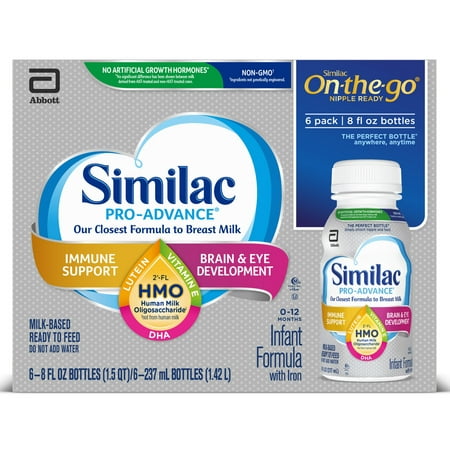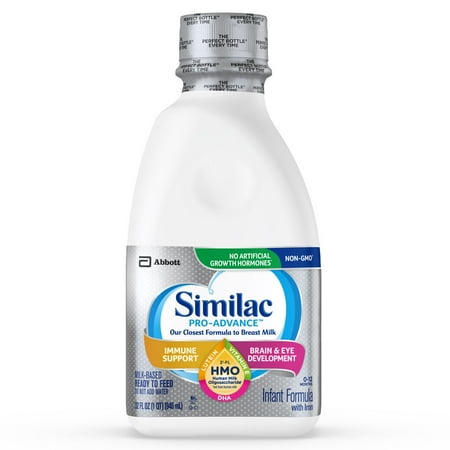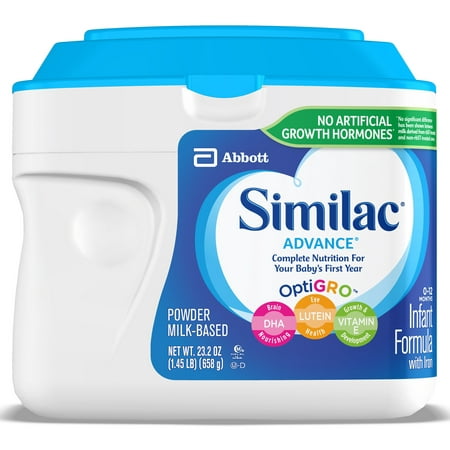Similac Pro-Advance Infant Formula with 2′-FL Human Milk Oligosaccharide (HMO) for Immune Support, Ready to Feed, 8 fl oz bottles, 6 count
Similac Pro-Advance with 2’-FL human milk oligosaccharide* provides immune support by encouraging immune cells to release protective proteins in amounts more like the breastfed baby. It’s also the first leading infant formula with no artificial growth hormones. Parents reported a reduction in fussiness, gassiness, crying, and spit-up after just 1 day of feeding, and the improvement was maintained while feeding the formula. Our exclusive blend of DHA, Lutein, and Vitamin E is important for helping support baby’s brain and eye development. You can trust Similac, the #1 infant formula brand chosen by mom’s and the #1 brand fed in hospitals. *Not from human milk.No significant difference has been shown between milk derived from rbST-treated and non-rbST-treated cows. After switching to Similac Pro-Advance. Total US infant formula, all outlets as of 3/31/2018, Nielsen data|in select stores, The SNAP (Supplemental Nutrition Assurance Program) name is a service mark of the U.S. Department of Agriculture. USDA does not endorse any goods, services, or enterprises.










#1 BRAND FOR IMMUNE SUPPORT*: Similac Pro-Advance is the first infant formula with 2’ FL HMO** designed to be closer than ever to breast milk. (*Based on Pediatrician Recommendations & IQVIA ProVoice Survey 12 months ending February 2020; **not from human milk)NO ARTIFICIAL GROWTH HORMONES: Similac is the first leading infant formula brand with no artificial growth hormones (No significant difference has been shown between milk derived from rbST-treated and non-rbST-treated cows)REDUCED FUSSINESS: Parents reported reduced fussiness, gassiness, and spit-up after 1 day (After switching to Similac Pro-Advance)TRUSTED: Similac is the #1 infant formula brand chosen by moms* and the #1 brand fed in hospitals (*total US infant formula all outlets as of 3/31/18, Nielsen data)BRAIN & EYE DEVELOPMENT: Our exclusive blend of DHA, Lutein, and Vitamin E – nutrients also found in breast milk – helps support baby’s overall growth and brain and eye developmentAccepting SNAP EBT on Grocery Pick Up for this Item
2 (two) is a number, numeral and digit. It is the natural number following 1 and preceding 3. It is the smallest and only even prime number. Because it forms the basis of a duality, it has religious and spiritual significance in many cultures.
6 (six) is the natural number following 5 and preceding 7. It is a composite number and the smallest perfect number.
Advance commonly refers to:
- Advance, an offensive push in sports, games, thoughts, military combat, or sexual or romantic pursuits
- Advance payment for goods or services
- Advance against royalties, a payment to be offset against future royalty payments
Advance may also refer to:
Count (feminine: countess) is a historical title of nobility in certain European countries, varying in relative status, generally of middling rank in the hierarchy of nobility. Especially in earlier medieval periods the term often implied not only a certain status, but also that the count had specific responsibilities or offices. The etymologically related English term "county" denoted the territories associated with some countships, but not all.
Although the term count was not generally used in England, after the 1066 conquest by the Normans, various European terms for count eventually became the normal translations used for the English title of earl, and the wives of earls are still referred to as countesses.
In science, a formula is a concise way of expressing information symbolically, as in a mathematical formula or a chemical formula. The informal use of the term formula in science refers to the general construct of a relationship between given quantities.
The plural of formula can be either formulas (from the most common English plural noun form) or, under the influence of scientific Latin, formulae (from the original Latin).
Humans (Homo sapiens) or modern humans are the most common and widespread species of primate, and the last surviving species of the genus Homo. They are great apes characterized by their hairlessness, bipedalism, and high intelligence. Humans have large brains, enabling more advanced cognitive skills that enable them to thrive and adapt in varied environments, develop highly complex tools, and form complex social structures and civilizations. Humans are highly social, with individual humans tending to belong to a multi-layered network of cooperating, distinct, or even competing social groups – from families and peer groups to corporations and political states. As such, social interactions between humans have established a wide variety of values, social norms, languages, and traditions (collectively termed institutions), each of which bolsters human society. Humans are also highly curious: the desire to understand and influence phenomena has motivated humanity's development of science, technology, philosophy, mythology, religion, and other frameworks of knowledge; humans also study themselves through such domains as anthropology, social science, history, psychology, and medicine. As of May 2024, there are estimated to be more than 8 billion humans alive.
Although some scientists equate the term "humans" with all members of the genus Homo, in common usage it generally refers to Homo sapiens, the only extant member. All other members of the genus Homo, which are now extinct, are known as archaic humans, and the term "modern human" is used to distinguish Homo sapiens from archaic humans. Anatomically modern humans emerged around 300,000 years ago in Africa, evolving from Homo heidelbergensis or a similar species. Migrating out of Africa, they gradually replaced and interbred with local populations of archaic humans. Multiple hypotheses for the extinction of archaic human species such as Neanderthals include competition, violence, interbreeding with Homo sapiens, or inability to adapt to climate change.
For most of their history, humans were nomadic hunter-gatherers. Humans began exhibiting behavioral modernity about 160,000–60,000 years ago. The Neolithic Revolution, which began in Southwest Asia around 13,000 years ago (and separately in a few other places), saw the emergence of agriculture and permanent human settlement; in turn, this led to the development of civilization and kickstarted a period of continuous (and ongoing) population growth and rapid technological change. Since then, a number of civilizations have risen and fallen, while a number of sociocultural and technological developments have resulted in significant changes to the human lifestyle.
Genes and the environment influence human biological variation in visible characteristics, physiology, disease susceptibility, mental abilities, body size, and life span. Though humans vary in many traits (such as genetic predispositions and physical features), humans are among the least genetically diverse primates. Any two humans are at least 99% genetically similar. Humans are sexually dimorphic: generally, males have greater body strength and females have a higher body fat percentage. At puberty, humans develop secondary sex characteristics. Females are capable of pregnancy, usually between puberty, at around 12 years old, and menopause, around the age of 50.
Humans are omnivorous, capable of consuming a wide variety of plant and animal material, and have used fire and other forms of heat to prepare and cook food since the time of Homo erectus. Humans can survive for up to eight weeks without food and several days without water. Humans are generally diurnal, sleeping on average seven to nine hours per day. Childbirth is dangerous, with a high risk of complications and death. Often, both the mother and the father provide care for their children, who are helpless at birth.
Humans have a large, highly developed, and complex prefrontal cortex, the region of the brain associated with higher cognition. Humans are highly intelligent and capable of episodic memory; they have flexible facial expressions, self-awareness, and a theory of mind. The human mind is capable of introspection, private thought, imagination, volition, and forming views on existence. This has allowed great technological advancements and complex tool development through complex reasoning and the transmission of knowledge to subsequent generations through language.
An infant or baby is the very young offspring of human beings. Infant (from the Latin word infans, meaning 'baby' or 'child') is a formal or specialised synonym for the common term baby. The terms may also be used to refer to juveniles of other organisms. A newborn is, in colloquial use, an infant who is only hours, days, or up to one month old. In medical contexts, a newborn or neonate (from Latin, neonatus, newborn) is an infant in the first 28 days after birth; the term applies to premature, full term, and postmature infants.
Infants born prior to 37 weeks of gestation are called "premature", those born between 39 and 40 weeks are "full term", those born through 41 weeks are "late term", and anything beyond 42 weeks is considered "post term".
Before birth, the offspring is called a fetus. The term infant is typically applied to very young children under one year of age; however, definitions may vary and may include children up to two years of age. When a human child learns to walk, they are called a toddler instead.
Milk is a white liquid food produced by the mammary glands of mammals and the caecilian Siphonops annulatus. It is the primary source of nutrition for young mammals (including breastfed human infants) before they are able to digest solid food. Immune factors and immune-modulating components in milk contribute to milk immunity. Early-lactation milk, which is called colostrum, contains antibodies that strengthen the immune system and thus reduce the risk of many diseases. Milk contains many nutrients, including calcium and protein, but also lactose and saturated fat.
As an agricultural product, dairy milk is collected from farm animals. In 2011, dairy farms produced around 730 million tonnes (800 million short tons) of milk from 260 million dairy cows. India is the world's largest producer of milk and the leading exporter of skimmed milk powder, but it exports few other milk products. Because there is an ever-increasing demand for dairy products in India, it could eventually become a net importer of dairy products. New Zealand, Germany, and the Netherlands are the largest exporters of milk products. The US Centers for Disease Control and Prevention recommends that children over the age of 12 months should have two servings of dairy milk products a day.
More than six billion people worldwide consume milk and milk products, and between 750 and 900 million people live in dairy-farming households.
An oligosaccharide (; from Ancient Greek ὀλίγος (olígos) 'few', and σάκχαρ (sákkhar) 'sugar') is a saccharide polymer containing a small number (typically three to ten) of monosaccharides (simple sugars). Oligosaccharides can have many functions including cell recognition and cell adhesion.
They are normally present as glycans: oligosaccharide chains are linked to lipids or to compatible amino acid side chains in proteins, by N- or O-glycosidic bonds. N-Linked oligosaccharides are always pentasaccharides attached to asparagine via a beta linkage to the amine nitrogen of the side chain. Alternately, O-linked oligosaccharides are generally attached to threonine or serine on the alcohol group of the side chain. Not all natural oligosaccharides occur as components of glycoproteins or glycolipids. Some, such as the raffinose series, occur as storage or transport carbohydrates in plants. Others, such as maltodextrins or cellodextrins, result from the microbial breakdown of larger polysaccharides such as starch or cellulose.
Pro is an abbreviation meaning "professional".
Pro, PRO or variants thereof might also refer to:





Reviews
There are no reviews yet.